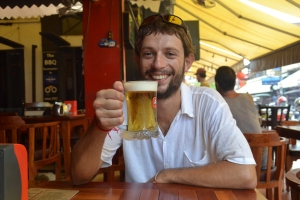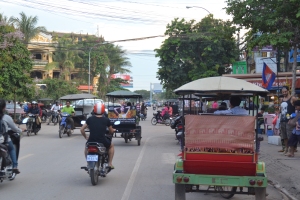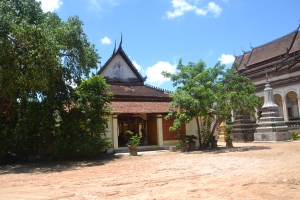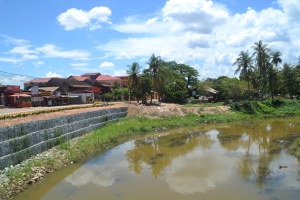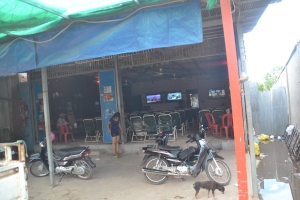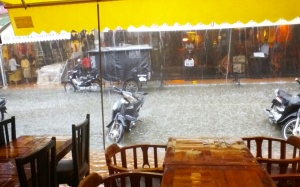Our first stop in Cambodia was Siem Reap, a city popular for its closeness to the Angkor Historical Park.
Before visiting the park we wanted to have a few days to explore the city and get a bit of a feel for Cambodia. The differences between here and Thailand – despite being geographically so close – are massive in terms of infrastructure. For example the roads aren’t as good, they’re either dotted with huge potholes or are simply gravel tracks, the vehicles (not bikes) are much older and generally in worse condition and people generally have the cheaper semi-automatic bikes like Honda Dreams. Although the city is growing there are few new buildings and nothing higher than 3/4 stories. The most beautiful buildings architecturally are from the French occupation early in the century.
We can only assume these differences are a result from the Khmer Rouge dictatorship where Pol Pot massacred any of the population who were deemed intellectual (doctors, teachers, engineers, artists etc.) seriously damaging the country’s development – economic, educational, cultural and technological. It’s hard to fully describe how we can see the effects of this but you can somehow feel it.
Siem Reap is only a small city so we decided that renting a bicycle would be the easiest way to get around. For 0.75$ a day, we picked up two Dutch style bikes with baskets from a lovely old lady opposite our hotel, she had no English and only half her fingers. Armed with our bikes and plenty of water we made our way into town. Sounds simple but the roads here are something else…
Worse than Thailand, even worse than Indonesia, there seem to be no rules at all here. Riding on the right side (due to the French influence) we had people coming at us from all directions. Lanes are more or less half of the road but there are also extra ‘lanes’ on the kerb side for people wanting to join traffic going in the opposite direction. Junctions are simply perilous. Jake’s advice was not to stop, not so easy when people are crossing in front, behind and overtaking you on both sides all at once. Turning right is ok-ish, but left is just dangerous. Jake thinks this is quite a lot of fun, but he does have an extra 1800km of S.E. Asian driving under his belt.
Once in town we cycled around to some of the major temples, Wat Bo and Wat Preah Prom Rath. Unlike in Thailand where the temples are laid out for visitors – signage for parking, which temple is open and which isn’t. The temples in the city here seem to be more to house monks, schools and hospitals rather than a tourist attraction.
Siem Reap has several markets, mostly selling souvenirs, local crafts and handiworks. Although we western really interested in buying at the moment, we thought it would be nice to have a wander around the stalls. However, pausing for too long meant the shop owner would be at your elbow eagerly urging you to buy something, anything from their stall. Offering prices then halving them when we said we wern’t interested. Some even started talking about children they had to feed. After a while this forcefulness took the enjoyment out of browsing.
The food market was huge and sold everything from the usual coffees, teas, exotic fruits a whole array of breads and cakes to dried strips of meat, live fish and ice.
I had read a lot about the poverty in this country and of children begging but to see it really brought it home just how much wealthier we in the west are than the people living in this part of the world. Everywhere in the city you see children in filthy clothes collecting recycling or begging. They walk around, tug your shorts and say ‘one dollar, one dollar’. It’s hard to know what to do in situations like this, on one hand we’ve read than giving money encourages begging and the Cambodian government is trying to stop this (I don’t know how) but on the other hand you have a child there asking for money to live. We might be wrong but we’d rather give something more than money. However, since I first typed this blog I’ve read more about these children, and it doesn’t get any better. I’ve read that their parents keep them out of school and on the streets because they can earn more doing this then sitting in a classroom. It’s an extremely short sighted perspective and only ensures the children themselves grows up with few prospects except for the street. We’ve offered these children other things; a pen, a sweet, an English coin or other food and they refuse. Money is what their parents expect to see. Often a baby of 2/3 years would come up to us as we were sitting having a drink and simply stand in front of us for 5 minutes more, it’s mother to the side watching often clutching another child or two. It’s been extremely difficult watching children be used like this knowing it’s having a detriment on their future.
Anyway, on our cycle around town we spotted signs for the marina so decided to go have a look. After 20minutes cycling along the river we didn’t seem to be coming to any marina – it wasn’t until we looked at the map that we realized the marina was on the banks of Tonle Sap lake – a 16,700km2 lake in the centre of Cambodia (in monsoon season). Seeing where we were on the map it didn’t look as ‘around the corner’ as people had described so, to save cycling in the midday heat any longer we turned round and made our way back to the city, and to some shade.
Cycling this far out of town gave us an idea of Cambodia, away from the hotels and restaurants catering for tourists in the city. Here, houses made from corrugated metal were neighbours with beautiful, gated buildings. Of course we only get a skewed perspective looking at it from the outside but even so, life seems so much simpler here than in the city. A local we were chatting to described how families in a village tend to firstly stay in the village their whole lives (or go away for education or work and then come back) and secondly that they have a great sense of community. If someone needs help wit childcare, harvesting their crop, building something the whole community is on call to help out. I guess that’s the difference between city and county living. As is the case for us, he said that this community spirit is lost in the city, taken over by a faster lifestyle. It was interesting to hear this comparison and see the similarities with our own country; it’s true that in cities people tend to think more selfishly, of themselves and their own.
Cycling back to our hotel we passed a small corrugated roof building which housed what we later found to be a cinema. Get rid of images of plush comfy chairs, big screens and popcorn, this local cinema was simply rows of deckchairs lined up in front of several screens. On each screen a different movie or TV programme was playing. They sold snacks – noodles, things on sticks (bbq food) and tropical fruits like lychee. It seemed to be open all day and was immensely popular with the locals, of an evening there would be dozens of bikes and bicycles parked outside. Of course, in the centre of the city there were cinemas which would be familiar to us, this was just a local mini cinema set up so those who couldn’t afford a TV back home could still watch it.
One of the best things about Cambodia so far are the baguettes. As it is an ex-French colony the Cambodians have taken up baking and bread making with a passion. People sell baguettes on carts either attached to their bike or pushed by hand. Thing is, it seems you can only get one kind – mackerel with tofu and pork, cucumber, onion and carrot with various chili oils and sauces generously added on top. A bit of a strange combination at first but Jake seemed to really take to them.
Our final day in the city we spent as a lazy day – we took a walk into town to buy our bus ticket to Battambang and went for a read and a drink in a restaurant. Then the rain started.
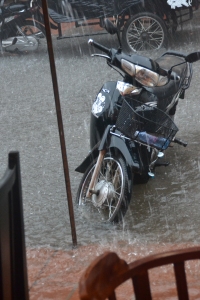
We ended up ‘stuck’ in a restaurant for hours as the rain kept falling and falling. Gutters overflowed and the overflow came right up the curb and very nearly into the restaurant. It was quite amusing watching people dart into tuk tuks up to their shins in dirty water. Even better was when a tuk tuk or van stopped and very dry people looked out with a look of horror at what they had to face to get to the restaurants and bars.
